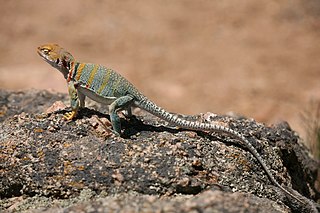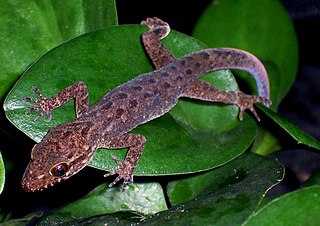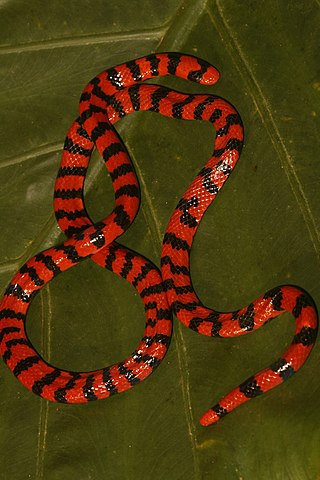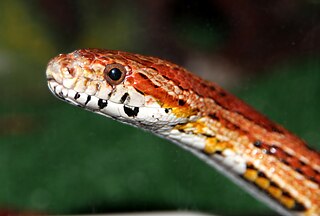
The Lepidosauria is a subclass or superorder of reptiles, containing the orders Squamata and Rhynchocephalia. Squamata includes snakes, lizards, and amphisbaenians. Squamata contains over 9,000 species, making it by far the most species-rich and diverse order of non-avian reptiles in the present day. Rhynchocephalia was a formerly widespread and diverse group of reptiles in the Mesozoic Era. However, it is represented by only one living species: the tuatara, a superficially lizard-like reptile native to New Zealand.

The Crotaphytidae, or collared lizards, are a family of desert-dwelling reptiles native to the Southwestern United States and northern Mexico. Alternatively they are recognized as a subfamily, Crotaphytinae, within the clade Pleurodonta. They are very fast-moving animals, with long limbs and tails; some species are capable of achieving bipedal running at top speed. This species is carnivorous, feeding mainly on insects and smaller lizards. The two genera contain 12 species.

Cyrtodactylus is a diverse genus of Asian geckos, commonly known as bent-toed geckos, bow-fingered geckos, and forest geckos. The genus has 354 described species as of 2023, which makes it the largest of all gecko genera.

Johann Georg Wagler was a German herpetologist and ornithologist.

The Aniliidae are a monotypic family created for the monotypic genus Anilius that contains the single species Anilius scytale. Common names include the American pipe snake and false coral snake. It is found in South America. This snake possesses a vestigial pelvic girdle that is visible as a pair of cloacal spurs. It is ovoviviparous. It is non-venomous, and its diet consists mainly of amphibians and other reptiles. Two subspecies are recognized, including the nominate subspecies described here.

Xenopeltis, the sunbeam snakes, are the sole genus of the monotypic family Xenopeltidae, the species of which are found in Southeast Asia. Sunbeam snakes are known for their highly iridescent scales. Three species are recognized, each one with no subspecies. Studies of DNA suggest that the xenopeltids are most closely related to the Mexican burrowing python and to the true pythons (Pythonidae).

Trimeresurus is a genus of venomous pit vipers found in Asia from the Indian Subcontinent throughout Southeast Asia, China, and the Pacific Islands. Currently 44 species are recognized. Common names include Asian palm pit vipers, Asian lanceheads, and green pit vipers.

Oligodon is genus of colubrid snakes that was first described by Austrian zoologist Leopold Fitzinger in 1826. This genus is widespread throughout central and tropical Asia. The snakes of this genus are commonly known as kukri snakes.

Pantherophis is a genus of nonvenomous colubrid snakes endemic to central and eastern regions of North America. It consists of the North American ratsnakes, the foxsnakes, and the cornsnakes. The genus, which contains 10 recognized species, first appeared in the fossil record in the Middle Miocene around 16.3 million years ago. They are a large terrestrial snake genus that lack subocular scales. Originally classified in the genus Elaphe, phylogenetic studies have found this taxon to be closely related to Pituophis. As with all snakes Pantherophis is an obligate faunivore with a diet that consists of small mammals, birds, reptiles and amphibians, and even insects. While many species conservation status is categorized as "least concern", many local populations in some species have declined where some places have them listed as federally protected. The corn snake is a popular pet reptile, due to the availability of captive-bred animals, their low maintenance and calm disposition, and the variety of color morphs. There are other species of Pantherophis that are in the pet trade, though are not as popular as the corn snake.

Trimeresurus albolabris, the white-lipped pit viper or white-lipped tree viper, is a venomous pit viper species endemic to Southeast Asia.

The red-tailed pipe snake, red cylinder snake, or common pipe snake is a nonvenomous cylindrophiid snake species found in Southeast Asia. No subspecies are currently recognized.

The Alethinophidia are an infraorder of snakes that includes all snakes other than blind snakes and thread snakes. Snakes have long been grouped into families within Alethinophidia based on their morphology, especially that of their teeth. More modern phylogenetic hypotheses using genetic data support the recognition of 19 extant families, although the taxonomy of alethinophidian snakes has long been debated, and ultimately the decision whether to assign a particular clade to a particular Linnaean rank is arbitrary.

Anomochilus monticola, the Kinabalu giant blind snake, mountain pipe snake, or Mount Kinabalu dwarf pipesnake, is a species of snake in the dwarf pipesnake family Anomochilidae. It is endemic to Kinabalu Park in northern Borneo, where it inhabits montane and submontane rainforest at altitudes of 1,450–1,513 m (4,757–4,964 ft). Described by the herpetologist Indraneil Das and colleagues in 2008, the species is a stout, cylindrical snake with a small head and short, conical tail. It is the largest species in its genus, with a total length of 521 mm (20.5 in). It is mostly iridescent blue-black in color, with a deep brown belly, large pale horn-colored blotches along the underside, a chrome orange band around the tail, a pale creamy-yellow bar across the snout, and pale horn-colored speckles along its sides. It can be told apart from the other species in its genus by its large size, the absence of a stripe along its sides, and the lack of pale blotches on its back.
Wilson's blind snake is a species of snake in the family Leptotyphlopidae. The species is native to Yemen.

Pseudoxenodontinae is a small subfamily of colubroid snakes, sometimes referred to as a family (Pseudoxenodontidae). They are found in southern and southeastern Asia, from northeast India to southern China and south into Indonesia as far east as Wallace's Line. There are 10 species in 2 genera. Most are very poorly known, such that Pseudoxenodontinae is one of the most poorly known groups of snakes.
Gyiophis is a genus of snakes in the family Homalopsidae. The genus is endemic to Myanmar.
Muhtarophis barani, also known commonly as Baran's black-headed dwarf snake, is a species of snake in the monotypic genus Muhtarophis in the subfamily Colubrinae of the family Colubridae. The species is endemic to the Amanos Mountains of Turkey, and was discovered in 2007.

The Amerophidia, also known as amerophidian snakes, are a superfamily of snakes that contains two families: Aniliidae and the boa-like Tropidophiidae.

The Colubroides are a clade in the suborder Serpentes (snakes). It contains over 85% of all the extant species of snakes. The largest family is Colubridae, but it also includes at least six other families, at least four of which were once classified as "Colubridae" before molecular phylogenetics helped in understanding their relationships. It has been found to be monophyletic.
Jodi J. L. Rowley is an Australian herpetologist and conservationist.















